Hands-On With the Xiaomi Mi5 - High-End at a Mid-Range Price
by Andrei Frumusanu on February 25, 2016 10:15 AM EST- Posted in
- Smartphones
- Mobile
- Xiaomi
- Mi5
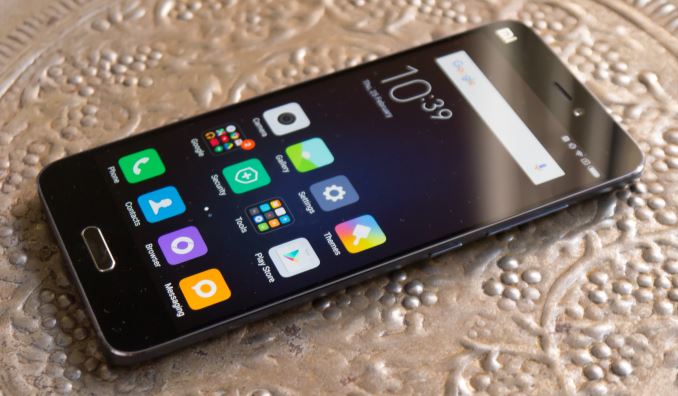
It’s been over 18 months since Xiaomi announced the Mi 4 back in June 2014, and today the company is finally ready to release the sucessor in the form of the Mi 5. The western launch here in Barcelona was presented by VP of Global, Hugo Barra, and we were lucky enough to have the opportunity to live-blog the event and get a more in-depth hands-on later in the day. The Mi 5 is Xiaomi’s 5”-range form-factor flagship device and will be one of the main devices competing for buyer’s attention this generation.
In a fashion that is very popular with Chinese vendors, Xiaomi was eager to talk about the detailed specifications of the Mi 5 during its presentation, so without much ado, let’s go over the device’s full specification overview:
| Xiaomi Mi 5 | ||
| SoC | Snapdragon 820 2x Kryo Performance Cluster @ 1804 / 2154 MHz 2x Kryo Power Cluster @ 1363 / 1593 MHz Adreno 530 @ 624MHz |
|
| RAM | 3-4GB LPDDR4 @ 1333 / 1866MHz | |
| NAND | 32GB / 64GB / 128GB UFS NAND | |
| Display | 5.15” 1080p IPS LCD | |
| Modem | 2G/3G/4G LTE Cat 12 (Integrated Qualcomm X12 Modem) |
|
| Networks | TDD LTE | B38 / B39 / B40 / B41 |
| FDD LTE | B1 / B3 / B7 | |
| UMTS | 850 / 900 / 1900 / 2100 ( B8 / B5 / B2 / B1) |
|
| TD-SCDMA | B34 / B39 | |
| CDMA | BC0 | |
| GSM | 850 / 900 / 1800 / 1900 | |
| Dimensions | 144.55 (h) x 69.23 (w) x 7.25 (d) mm 129g weight (+10g for Ceramic version) |
|
| Camera | Rear Camera 16MP ( 4608 × 3456 ) Sony IMX298 1/2.8" w/ 1.12µm pixels F/2.0 aperture, 28mm eq. 4-axis (pitch, yaw, x&y translational) OIS |
|
| Front Facing Camera 4MP ( 2688 × 1512 ) 2.0µm pixels F/2.0 aperture |
||
| Battery | 3000mAh (11.55 Whr) | |
| OS | Android 6.0 with MIUI 7 | |
| Connectivity | 802.11a/b/g/n/ac dual-band 2.4 & 5GHz BT 4.2, USB-C, GPS/GNSS, NFC |
|
| SIM Size | NanoSIM | |
| MSRP | 32GB + 3GB + 1.8GHz + Glass Back |
RMB ¥1999 (USD~261, ~236€, ~187£) |
| 64GB + 3GB + 2.15GHz + Glass Back |
RMB ¥2299 (USD~300, ~272€, ~215£) | |
| 128GB + 4GB + 2.15GHz + Ceramic Back | RMB ¥2699 (USD~352, ~319€, ~252£) | |
At the heart of the Mi 5 we find the Snapdragon 820 processor powering the device. Xiaomi chose to use two different variants of the Snapdragon 820 depending on the configuration and price options. The lowest priced option with 32GB of storage comes with a lower-binned Snapdragon 820 whose Kryo cores reach up to 1.36GHz on the efficiency cluster and 1.8GHz on the performance cluster. Furthermore the 32GB version only supports LPDDR4 up to 1333MHz. The 64GB and 128GB options come with the full 1.59GHz/2.15GHz speed bins and 1866MHz memory.
Power efficiency of the new SoC has been a big discussion topic revolving the Snapdragon 820 and I know a lot of readers are impatient for new information on the matter, so I took the opportunity to try to measure the power draw of the new Kryo cores on the Mi5. The values presented here are just estimates based on power measurements from the device’s input charge power so there’s likely some voltage converter inefficiency at play and more thorough measurements in the future may result in lower figures.
| Estimated System Active Power - CPU Load + Per Core Increments (mW) |
||||
| SoC | 1 Core | 2 Cores | 3 Cores | 4 Cores |
| Snapdragon 820 Kryo @2.15GHz / 1.59GHz |
2055 | 3330 | 4147 | 4735 |
| - | +1275 (2.15GHz) |
+817 (1.59GHz) |
+588 (1.59GHz) |
|
| Kirin 950 Cortex A72 @2.3GHz |
1387 | 2255 | 3051 | 3734 |
| - | +868 | +796 | +683 | |
| Exynos 7420 Cortex A57 @2.1GHz |
1619 | 2969 | 4186 | 5486 |
| - | +1350 | +1217 | +1300 | |
We do see some significant improvements for Qualcomm and the Snapdragon 820 represents a substantial reduction in power over the Snapdragon 810 and 808. At first glance though it seems Qualcomm isn’t able to beat HiSilicon’s Kirin 950 in terms of efficiency – although it looks like it will be able to display better efficiency than the Exynos 7420. A bit worrisome was the rather high 1 core power load but it’s still too early to determine if this is CPU-core related or rather power from another SoC block. Nevertheless it seems that the Xiaomi Mi5 and other Snapdragon 820 devices should be able show off concrete improvements over last year’s flagship phones.
On the GPU side we see some good improvements as well, although it seems the Snapdragon 820’s GPU is yet again oversized for smartphone form-factors as power figures are well above sustainable thermal envelope of phones such as the Mi5, so significant long-term throttling should be expected.
Continuing on with the rest of the MI 5’s specifications, we find a 5.15” 1080p IPS LCD display. Xiaomi did well in staying with a 1080p display as it will help with DDIC and display controller power to achieve better battery life for device. Xiaomi went one step further to improve power efficiency of the screen and disclosed that they’re using more backlight LEDs than in conventional designs – 16 instead of the usual 12-14. According to Xiaomi, this enables the Mi5 to reach up to 600nits of brightness as well as increasing overall backlight efficiency by 17%. While we still have to verify all of these claims, what I did notice is that the quality of the IPS panel that Xiaomi uses on the Mi5 is excellent. The display’s viewing angles are among one of the best I’ve seen on an LCD panel so it’ll definitely be interesting to see if Xiaomi was also able to provide accurate colour reproduction.
Further hardware specifications on the internals of the device include a switch to UFS-based NAND storage which promises to reach data-rates of up to 450MB/s – a figure that I wasn’t quite able to reach as quick testing shows the NAND speed reaching only 239MB/s read and 30.76MB/s writes (AndroBench 4.0, 256/4KB buffers, 1 thread). It’s possible that Xiaomi is quoting numbers without encryption and FDE on Android 6.0 is slowing down the maximum achievable speeds by the hardware.
Design-wise, this might be Xiaomi’s best device to date. The designers were able to adopt the Mi Note’s bevelled back sides to achieve excellent in-hand feel. To improve on the Mi Note's design which only curved half-way through the side of the device, the Mi5 now also curves the metal frame to try to give a more continuous feel between the metal and the glass/ceramic. Although the device sports a 5.15” screen, thanks to the design it feels more like a 4.7” or smaller device. The in-hand feel is reminiscent of the Galaxy S7 and I’m definitely happy to see that companies this year focused on improving their ergonomics. The only area where I wish Xiaomi had improved a bit more was on the front edges of the device as the lack of 2.5D glass does accentuate the rather sharp feel of the metal frame on the front.
I mentioned glass/ceramic earlier, and yes, there is a distinction between glass and ceramic as the MI 5 will come in three variants with two options for the back material. The cheaper 32 and 64GB variants will come with a more traditional glass back, while the 128GB variant comes with a more premium ceramic back cover. Advantages of the ceramic version will be that it'll be much more scratch resistant due to the hardness of the ceramic. One thing that wasn't mentioned during the presentation, but does make a large difference in the device's rather light baseline weight of 129g is that the ceramic back adds in 10g more which was definitely noticeable when holding both variants of the phone.
The right side of the device sports a power button with a volume rocker above it. We find a SIM tray on the upper left side of the phone. At the top we see a IR blaster, microphone hole and the 3.5mm headphone jack. The bottom features a USB-C connector which is flanked by 4 speaker holes on each side, although similarly to Huawei’s devices only the right side contains a speaker as the opposing speaker grill serves only as a symmetrical design feature and housing for the main microphone.
The MI 5 is Xiaomi's first smartphone with a physical home button. Primary reason for this is the new inclusion of a fingerprint sensor whose accuracy I found to be quite high. I was also very impressed with the implementation of the device wakeup feature: If you wake the device via the home button then it will immediately unlock the device without showing the lock-screen, not requiring a second gesture or trial & error with reading the fingerprint after the initial press. When the device is unlocked the fingerprint sensor also acts as a capacitive button so you never actually have to press the button during normal usage beyond initially waking the device up, effectively enabling full capacitive button navigation for the Mi5.
On the camera side, Xiaomi has made a lot of improvements to the camera module. The Mi5 sports Sony's new IMX298 16MP sensor which sports phase-detection autofocus for fast focusing and deep-trench isolation for better colour reproduction and reduced noise. We saw the same sensor employed in the Mate 8 and while I wasn't yet able to published the revisited camera evaluation of that device, I wasn't overly impressed with the results of the camera, so hopefully Xiaomi this did a better job on the image processing side of things. The MI 5's optics consist of a 6-lens system with an aperture of F/2.0 and an 35mm equivalent focal length of 28mm.

A first in the smartphone industry is the introduction of a 4-axis optical image stabilization system which introduces transversal image stabilization on top of latitudinal and longitudinal stabilization. Effectively, the module is now able to move around sideways on a plane on top of correcting its pitch and yaw. The end result is quite impressive and represents one of the best OIS systems in current smartphones. The only thing missing now for a full-fledged 5-axis OIS system that can compensate any kind of shake is an added axis for rotational image stabilization.
Initial camera samples seem favorable to the Mi5 and are definitely a large improvement to past camera modules employed by Xiaomi. The interesting comparison here is again seeing the MI 5 against the Mate 8 as both employ the same sensor and similar optics with the same aperture - the difference being in other areas such as the image processing. In low-light situations the Mi5 performs well, but it's during the daylight where the Mi5 seems to shine as it's able to take some very good pictures.
Performance was a large focus-point during the Mi5’s presentation. The Snapdragon 820 is touted to bring a lot of speedup, but this doesn’t seem to materialize as well in most situations. In browser tests, the Mi5 doesn’t seem to be able to deliver much improvement over the performance scores that we benchmarked back in December on Qualcomm’s MDP/S platform. Xiaomi’s stock browser doesn’t look like it’s been optimized for the Kryo cores and thus doesn’t represent any improvement over Chrome, which is also testing relatively low versus competing ARM cores in the Snapdargon 810 and Kirin 950.

PCMark presents the same result when it comes to web-browsing, scoring lower than what the Snapdragon 810 could achieve.

The writing score is an important test for overall Android performance and the MI5 performs well here, although it gets beat by the Mate 8's Kirin 950 SoC.


The photo editing score is a GPU performance test and here of course the Mi5 performs admirably thanks to the powerful Adreno 530 GPU.
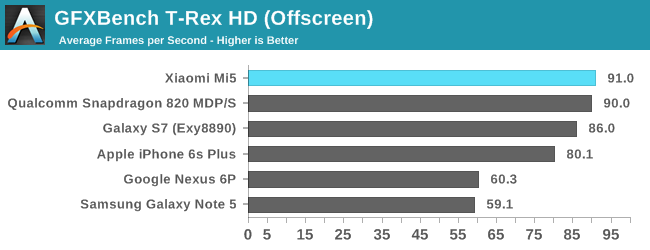

We weren't able to install any applications on LG's G5, so the Mi 5 serves as the first consumer device to confirm the benchmark scores we got back on the MDP/S platform. Here we see the Mi 5 perform very well and even slightly outpaces the MDP device, maybe due to newer drivers. Again it's to be noted that the device can get hot and preliminary power measurements show that it's very unlikely that the Mi 5 will be able to sustain these scores for extended periods of time.
The Mi 5 will be available in white, gold or black versions in three different options with either 32, 64 and 128GB for respectively RMB ¥1999 (USD~261, ~236€, ~187£), RMB ¥2299 (USD~300, ~272€, ~215£) and RMB ¥2699 (USD~352, ~319€, ~252£), non-Chinese prices converted without taxes. Xiaomi hasn't commented on availablility outside China or cellular band compatibility, but it's expected that the Mi 5 won't be compatible with NA carriers. European users will be more lucky to see LTE compatibility although it's unlikely that we'll see support for the important Band 20.
Overall I was fairly impressed with Xiaomi's new flagship device. The screen and design are definitely the highlights of the device. The Snapdragon 820 seems reasonable and represents a large improvement of Qualcomm's previous generation of SoCs. While there's still a lot more to test for the upcoming full review, in the short time I had with the device I didn't find any outstanding faults with the Mi 5 so it looks like Xiaomi was able to pull off a quite outstanding device that seems to be hard to beat in terms of price/performance ratio. Look forward to the full review in the upcoming weeks.


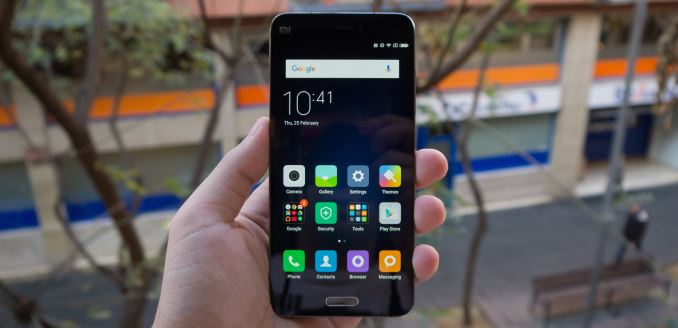


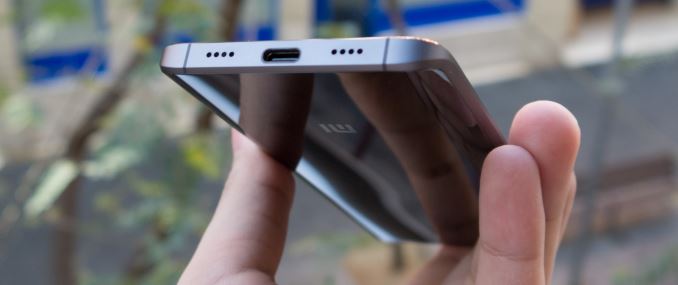








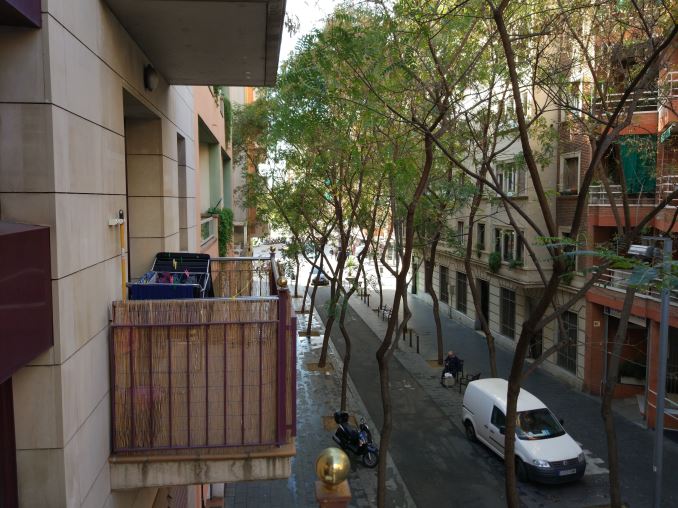







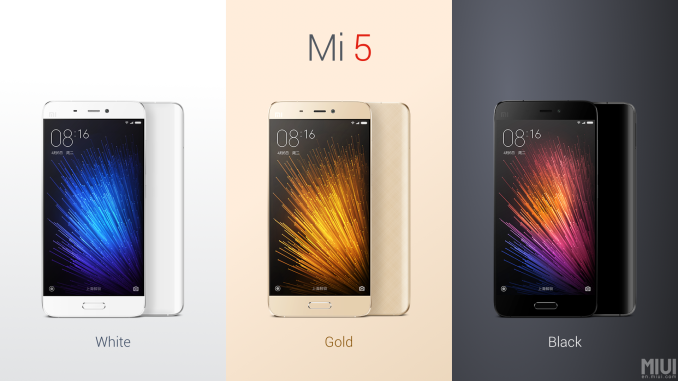








106 Comments
View All Comments
jjj - Thursday, February 25, 2016 - link
What i said was efficiency not power, efficiency factors in perf so, if you pay attention, you can safely assume that i have factored in perf.Your claim that a Kryo core is more powerful than A72 is based on what? Because you have nothing at all to support that claim and all existing evidence supports my claim,that in perf and power A72 is a lot better. If you take the Kirin 950 in Geekbench ( just because we actually have numbers in this benchmark) in integer and FP single core , it delivers 16% lower perf on average (lower diff in integer ,more in FP) with A72 at 2.3GHz while Kryo needs 50% more power at 2.15GHz- by looking at power for the 2 SoCs with 2 cores - just 2 cores because core 3 and 4 are lower clocks for Kryo. Kirin 950 is an early implementation , not the latest core revision, an older interconnect,likely not an ideal memory controller on an immature process. We will see better implementation and maybe even a slightly better Kirin soon.So i firmly stand by my claim that A72, based on these power numbers for Kryo , is a lot more efficient.
Additionally, the CPU related benchmarks on this page, place the Kirin ahead of Kryo, even with A72 at just 2.3GHz plus slower RAM and NAND - in all fairness Kryo might be crippled in this benchmark by Xiaomi's ROM.
As for your insults , after you learn how to read, maybe you can also learn how to have a conversation.
jjj - Thursday, February 25, 2016 - link
Ofc this math includes the all else power and if all else power would be equal (risky to assume that), it would get much worse for Kryo.lilmoe - Thursday, February 25, 2016 - link
For me, I'll reserve any judgement until a deep dive is done for all the major new cores; Kryo, M1, and A72.Adreno always benches better than Mali, but Mali always seems to perform better in real life (IE: more efficient).
jjj - Thursday, February 25, 2016 - link
In GPU it is a bit more complicated. The math includes the CPU so less efficient CPUs will harm the GPU perf too. Another very important matter is die size and that always gets left aside. IF Qualcomm was pushing clocks to save on die size, they could change that, go bigger , lower clocks and gain efficiency. Sadly i have no clue how big the GPU was in SD810. In any case, the GPU should be fine for 1440p even if it throttles a lot. At 1080p some could see it as overkill.As for M1, we'll see how hard they pushed it, would be nice if it stays cooler than others.
But Kryo vs A72 is surprising. Another way to look at these numbers is core 3+4 for both. Kryo at 1405mW clocked at just 1.6GHz but here there is an extra complication because Kryo seems to have a 512KB L2 cache for the 2 lower clock cores (vs 1MB L2 for the other 2) and that's why core 3 adds so much more than core 4. Both excluding that L2 or including it seem unfair, but it is less than the other 2 cores, less total than Kirin and some cache would be needed so we leave it in. For Kirin there is this graph http://images.anandtech.com/doci/9878/power-big_57... . There you can kinda guess core 3+4 power at 2GHz, it's not very precise but seems at about 1050mW. Went with 2GHz because in Geekbench Integer+FP average Kryo at 1.6Ghz would be at best a couple of % faster. So A72 delivers similar perf in Geekbench in this early implementation at much lower power when doing the math this other way that better isolates the core and clocks are not pushed too far. Even here the memory speed is different so perf and thermals will vary a bit and how memory heavy an app is would matter. The budget version of this device does have the same memory speed as the Kirin so would be more interesting to compare that one with the Mate 8.
Ofc all this is based on the limited available data, but that's all we got so far. Ignoring the little cores is not fair either because they are more efficient and they do offload some work, that is a plus in perf+power and a minus in cost.
lilmoe - Friday, February 26, 2016 - link
Yes, CPU power draw plays a big role in GPU efficiency, not question there.Both Kryo and M1 are at their early stages. Their "maturity" is comprable to A57 and Swift/Cyclone rather than A72 and Twister at this point (again, "maturity" not "performance"). I was a little surprised at first when Qualcomm added "little cores" to their design. But it's understandable; they either need more work on the dynamic scaling (lower voltage at low/medium clocks), or it's a decision dictated by how Android scheduling works based on evidence and recent articles. Either way, they still have lots of space for improvement, and we might see a quad core, all big, configuration with better voltage tuning in next iterations. But I wont hold my breath; they might need 10nm or less for an all big/wide configuration to be feasible on Android, and no less than Quad core, with only 1 or 2 cores configured for turbo.
Samsung, among other, "privileged", ARM partners has pretty early access to ARM designs. If the A72 was better than their M1 (same goes for the CCI), I'm sure they'd have went with that. Unless other design (and cost saving) decisions are at play, I'd voucher for the M1 over the A72. Heck, the M1 might even be a slightly modified A72.
There's also the difference in process nodes. I'm happy we now have a better apples to apples comparison between SD820 and Exynos 8890 since they're both on Samsung 14nm LPP. But until we see an A72 on Samsung's process vs TSMC, it'll still be hard to tell, even with more data.
I honestly don't believe these resent GPUs are overkill for 1080p, even for 720p. I envy how Apple can get away with a 720p screen on a ~5" device till this day, run by such a beefy GPU. I believe it has more to do with cost savings than optimal configuration (since their brand image allows it, and they'd sell either way). It's really sad that general perception dictates that Android OEMs need to have MUCH higher specs than Apple's to be considered as "good" alternatives till this day. I wish Samsung would enable the users to scale down the resolution (just like they can in the Game Tuner app) on the OS level. That 1440p pentile screen will sill look good scaled down to 720p since each pixel will have 5+ sub-pixels. Heck, color reproduction might even improve that way.
Optimizing for Android on the hardware level is proving to be extremely difficult. A royal pain in the behind. Google seems to be more interested on optimizing their software for more cores at this point. There's still WAY too much overhead in their rendering pipeline.
jjj - Friday, February 26, 2016 - link
To add something i've omitted, the slower Kryo are supposed to be optimized for power so that might have helped Kryo in this core 3+4 math.Don't see the point in Qualcomm going back to 4 instead of 2+2 since the single threaded perf gain this config allows, helps marketing. There were some rumors about MSM8996 Pro or SD823 but from China and China rumors are 90% fake.
In the end "overheating" in itself is not the problem, the lack of disclosure is. If the specs would disclose sufficient details so the consumer can be well enough informed, all would be ok. "Turbo" or"boost"or w/e marketing term one wants to use, is a good thing, as long as the consumer goes in knowing what he gets. Synthetic benchmarks don't help either in showing the real world behavior of a thermally managed SoC, things need to change there.
The M1 in Geekbench seems to match Kryo in memory , a very high score. . Why Samsung is using it, hard to say, they could have aimed higher, missed targets and got stuck with it, or maybe it is even better than A72 and not pushed too far. For M1 we really don't have much info yet, or at least i haven't seen much. On the interconnect side, Kirin uses CCI-400, that's why i've mentioned it as a possible area where things can get better. On the process, Qualcomm chose to go with Samsung not TSMC, sure the deal might have been about more than just the process since Samsung needs foundry clients and Qualcomm needs the S7 win. But doubt Qualcomm would have went with Samsung if the process was far worse than what TSMC has.
On the GPU side, as far as i can tell in actual games i do deem the perf as enough for current games but i don't see the need for 60FPS, some might. Sure mobile games could be much better and , no matter what, GPUs won't really be enough at any point soon.
The convo about quality, res, FPS and what matters most is tricky. I do agree that users should be able to adjust res. A smart device could adjust all 3 on the fly in trying too offer the best experience possible - that's not easy but could be done at some point. ARM announced recently the Mali DP650 that supports variable refresh rates , can't wait to see that in phones.
More cores can be a plus for gaming, if developers would try to use the small cores as much as possible and gain some GPU TDP. We might see even more than 10 cores and forcing games on more efficient cores could be a big plus. Consoles using 8 rather small cores could make console ports interesting.
Just spotted a fresh article, Digitimes is saying that Samsung is using SD820 only in the US (others are saying US and China) and that only the SD820 model uses the heatpipe.
Remains to be seen how true this is, Digitimes is not always reliable.
jjj - Friday, February 26, 2016 - link
The single core Kryo number is odd, Compare 1 and 2 cores with Exynos and ... maybe it's the way power was measured or maybe Xiaomi forgot a faucet running and it could end up being a bit better overall. Adjusting the core 1 number wouldn't change the core 3+4 math though.aegisofrime - Monday, February 29, 2016 - link
I found it odd as well. One possibility that I thought of is what if the Huawei had a full charged battery while the Xiaomi was on low charge. The Xiaomi would then be drawing full current since the measurement methodology was measuring input charge power. Conversely the Huawei would then be trickle charging thus pulling lesser power. I do consider this highly unlikely since its Andrei doing the testing here.Dovahkiin - Tuesday, March 1, 2016 - link
I wouldn't be surprised, that given it's likely a development firmware, it likely has flags toggled that keep portions of the SOC at full power for debug purposes.Dovahkiin - Tuesday, March 1, 2016 - link
POTENTIALLY, QC 3.0 may be a factor too.